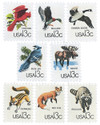
1978 13c CAPEX Wildlife stamps,First U.S. stamps issued in Canada
# 1757a-h - 1978 13c CAPEX Wildlife stamps - First U.S. stamps issued in Canada
$3.50 - $24.95
U.S. #1757a-h
1978 13¢ CAPEX Wildlife
Issue Date: June 10, 1978
City: Toronto, Canada
Quantity: 15,170,400
Quantity: 15,170,400
Printed By: Bureau of Engraving and Printing
Printing Method: Lithographed, engraved
Perforations: 11
Color: Multicolored
Issued in conjunction with the 1978 Canadian Philatelic Exhibition in Toronto, the CAPEX souvenir sheet was the first U.S. souvenir sheet to be released outside the country. Eight different stamps, featuring popular animals and birds from North America, appear together on this colorful sheet.
Known for their colorful plumage and cheerful, flute-like songs, the cardinal is a popular sight at back yard bird feeders. At one time, these birds were trapped and sold as songbirds, and their feathers were used to decorate women’s hats. Today, cardinals are protected by law.
The mallard is one of the most common of wild ducks. The male, which is known for its striking plumage of greens, purples, and rust, loses most of its brightly-colored feathers after breeding season. During the winter months, the mallard, which nests in prairie marshes and ponds in the spring, migrates to southern wetlands.
For many northerners, the migration of the majestic Canada goose signals the beginning of winter. During the autumn months, these birds fly as far south as northern Florida and Mexico. Although the giant Canada goose is the most common species, there are 10 other species, including the smallest – the cackling Canada goose, which weighs only 3 pounds.
With its brilliant blue plumage, the blue jay is easy to spot. A relative of crows and magpies, it’s known for its bold, aggressive behavior. When angered, the blue jay sounds as if it’s shouting “Thief! Thief!”
Found in forests throughout the world, the moose is the largest member of the deer family. The average moose stands about 6 1/2 feet tall, although some have grown as tall as 7 1/2 feet. This animal is so massive that even a wolf pack cannot kill a moose unless it is old or sick.
A member of the rodent family, the chipmunk can be found in forests as well as city parks. These charming little animals spend much of the spring and summer months collecting food for winter.
Along with the arctic fox, the red fox, which is valued for its long, soft fur, is the most common type found in the U.S. and Canada. Although the majority of red foxes have reddish coats, some may have silver coats – black tipped with white.
The raccoon is easily recognized by the “mask” of black hair around its eyes, and its bushy ringed tail. American Indians and early settlers used to hunt this animal for fur, and the pelts were also used as money before paper currency was established.
U.S. #1757a-h
1978 13¢ CAPEX Wildlife
Issue Date: June 10, 1978
City: Toronto, Canada
Quantity: 15,170,400
Quantity: 15,170,400
Printed By: Bureau of Engraving and Printing
Printing Method: Lithographed, engraved
Perforations: 11
Color: Multicolored
Issued in conjunction with the 1978 Canadian Philatelic Exhibition in Toronto, the CAPEX souvenir sheet was the first U.S. souvenir sheet to be released outside the country. Eight different stamps, featuring popular animals and birds from North America, appear together on this colorful sheet.
Known for their colorful plumage and cheerful, flute-like songs, the cardinal is a popular sight at back yard bird feeders. At one time, these birds were trapped and sold as songbirds, and their feathers were used to decorate women’s hats. Today, cardinals are protected by law.
The mallard is one of the most common of wild ducks. The male, which is known for its striking plumage of greens, purples, and rust, loses most of its brightly-colored feathers after breeding season. During the winter months, the mallard, which nests in prairie marshes and ponds in the spring, migrates to southern wetlands.
For many northerners, the migration of the majestic Canada goose signals the beginning of winter. During the autumn months, these birds fly as far south as northern Florida and Mexico. Although the giant Canada goose is the most common species, there are 10 other species, including the smallest – the cackling Canada goose, which weighs only 3 pounds.
With its brilliant blue plumage, the blue jay is easy to spot. A relative of crows and magpies, it’s known for its bold, aggressive behavior. When angered, the blue jay sounds as if it’s shouting “Thief! Thief!”
Found in forests throughout the world, the moose is the largest member of the deer family. The average moose stands about 6 1/2 feet tall, although some have grown as tall as 7 1/2 feet. This animal is so massive that even a wolf pack cannot kill a moose unless it is old or sick.
A member of the rodent family, the chipmunk can be found in forests as well as city parks. These charming little animals spend much of the spring and summer months collecting food for winter.
Along with the arctic fox, the red fox, which is valued for its long, soft fur, is the most common type found in the U.S. and Canada. Although the majority of red foxes have reddish coats, some may have silver coats – black tipped with white.
The raccoon is easily recognized by the “mask” of black hair around its eyes, and its bushy ringed tail. American Indians and early settlers used to hunt this animal for fur, and the pelts were also used as money before paper currency was established.












